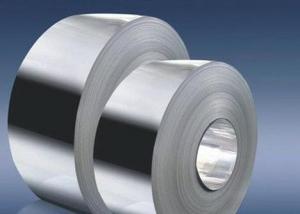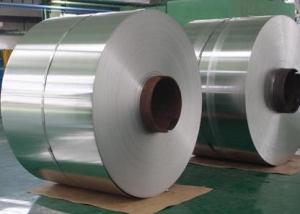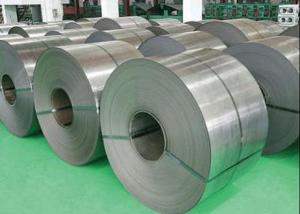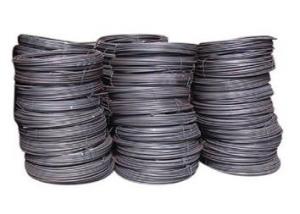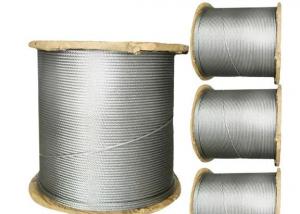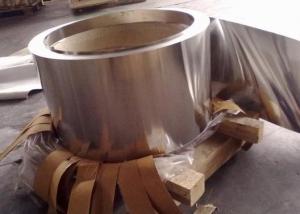304L Stainless Steel Strips
- Loading Port:
- China Main Port
- Payment Terms:
- TT or LC
- Min Order Qty:
- 1 Ton m.t.
- Supply Capability:
- 2000 Tons Per Month m.t./month
OKorder Service Pledge
OKorder Financial Service
You Might Also Like
304L Stainless Steel Strips
1. Chemical composition
|
C |
Si |
Mn |
P |
S |
Ni |
Cr |
|
Max0.03 |
Max1.00 |
Max2.00 |
Max0.045 |
Max0.03 |
9.0-13.0 |
18.0-20.0 |
2. Mechanical properties
|
Yield Strength |
Tensile |
Elongation |
Hardness (HV) |
Hardness (HRB) |
|
≥175 |
≥480 |
≥40 |
≤200 |
≤90 |
3. Standard: AISI, ASTM, GB, EN, DIN, JIS
4. Surface: 2B, NO.1, BA, NO.4, Hairline, SB, Mirror finish, Anti-skid, Cherkered etc.
5. Size: Thickness: 0.3-3mm (cold rolled), 3-40mm (hot rolled)
Width: 1000mm or 1219mm or 1240mm for cold rolled, 1500mm for hot rolled.
Length: As customers' request.
6. MOQ: 1 Ton
7. Payment terms: T/T or L/C
8. Packing: Seaworthy package with wooden or Iron pallets with the paper and the steel strip, or as customers' request.
9. Delivery time: Usually about 7 days after we confirming the order, or according to your quantity.
If you have any question or demand, pls feel free to contact me.
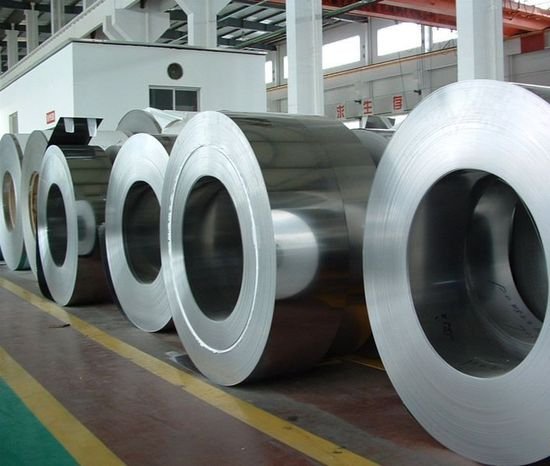


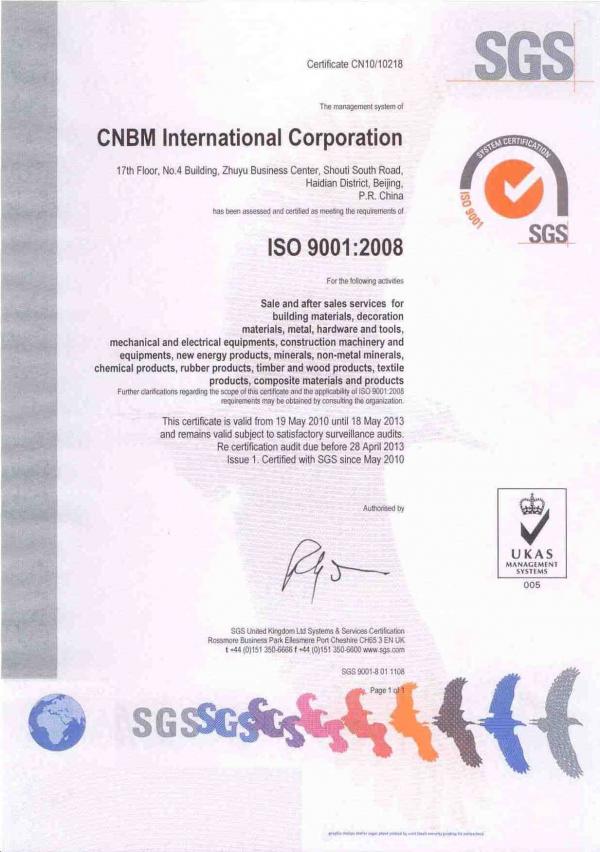
- Q:Can stainless steel wire be used for springs in the aerospace industry?
- Certainly! Stainless steel wire is applicable for springs in the aerospace industry. Renowned for its exceptional strength, corrosion resistance, and ability to withstand high temperatures, stainless steel serves as a fitting material for diverse aerospace implementations. It exhibits superior mechanical characteristics and can endure extreme conditions, including elevated pressure, temperatures, and harsh surroundings. Stainless steel springs assure dependable functionality, endurance, and longevity, all of which are pivotal aspects in aerospace applications that prioritize safety and reliability.
- Q:What are the different types of stainless steel wire rope constructions available?
- There are several different types of stainless steel wire rope constructions available, each designed for specific applications and requirements. Some of the common types include: 1. 1x19 Construction: This type of wire rope consists of one strand with 19 wires. It offers excellent strength and is commonly used for standing rigging applications, such as in sailboat rigging or architectural projects. 2. 7x7 Construction: This construction features seven strands, each consisting of seven wires. It provides good flexibility and is often used for applications like cable railing systems, garage door cables, and control cables. 3. 7x19 Construction: This construction is similar to the 7x7 construction but with additional wires, resulting in a total of 19 wires per strand. It offers higher flexibility and is commonly used for applications like winch lines, hoists, and crane cables. 4. 6x19 Construction: This construction consists of six strands, each with 19 wires. It provides a good balance of flexibility and strength, making it suitable for general-purpose applications like slings, winch cables, and guy wires. 5. 6x37 Construction: This construction features six strands, each with 37 wires. It provides excellent flexibility and high strength, making it ideal for heavy-duty applications like mining, logging, and offshore rigging. 6. 6x36 IWRC Construction: IWRC stands for Independent Wire Rope Core. This construction consists of six strands, each with 36 wires, and has an additional core made of independent wires. It offers high strength, durability, and resistance to crushing, making it suitable for applications like elevators, cranes, and suspension bridges. These are just a few examples of the different types of stainless steel wire rope constructions available. The choice of construction depends on factors such as the required strength, flexibility, corrosion resistance, and the specific application in which it will be used.
- Q:What are the different grades of stainless steel wire?
- There are several different grades of stainless steel wire, each with its own unique properties and uses. The most common grades include: 1. 302/304 Stainless Steel Wire: This grade is the most widely used stainless steel wire and is known for its excellent corrosion resistance. It is often used in applications such as jewelry making, wire mesh, and springs. 2. 316 Stainless Steel Wire: This grade is similar to 302/304 stainless steel wire but contains a higher percentage of molybdenum, which enhances its resistance to corrosion, particularly in marine environments. It is commonly used in marine equipment, chemical processing, and medical devices. 3. 430 Stainless Steel Wire: This grade is less corrosion-resistant compared to 302/304 and 316 stainless steel wires but provides good heat resistance and magnetic properties. It is often used in applications such as cooking utensils, automotive trim, and decorative wire. 4. 17-7 PH Stainless Steel Wire: This grade is a precipitation-hardening stainless steel wire that offers excellent strength, corrosion resistance, and fatigue resistance. It is commonly used in aerospace applications, springs, and fasteners. 5. 410 Stainless Steel Wire: This grade is a martensitic stainless steel wire with high strength and hardness. It offers good corrosion resistance and is often used in applications such as cutlery, surgical instruments, and valves. These are just a few examples of the different grades of stainless steel wire available. The choice of grade will depend on the specific requirements of the application, such as corrosion resistance, strength, heat resistance, and magnetic properties.
- Q:Can stainless steel wire be soldered?
- Yes, stainless steel wire can be soldered, but it requires the use of specialized solder and flux designed for stainless steel to ensure a strong and durable bond. Additionally, stainless steel's high heat conductivity makes soldering more challenging, often necessitating the use of a higher-powered soldering iron or torch.
- Q:What are the different types of stainless steel wire fences?
- There exist a variety of stainless steel wire fences, each possessing distinctive attributes and serving specific purposes. Here are a few commonly encountered types: 1. Woven Wire Fences: These fences are assembled through the interweaving of stainless steel wires in a crisscross manner. They are frequently utilized for agricultural applications, such as containing livestock or safeguarding crops from wildlife. Woven wire fences are available in diverse mesh sizes and wire gauges to accommodate varying requirements. 2. Welded Wire Fences: The construction of these fences involves the welding of stainless steel wires at their intersecting points, resulting in a robust and enduring structure. They are commonly employed for residential and commercial purposes, such as securing properties or establishing enclosures for pets. Welded wire fences can be tailored to specific needs by employing different wire diameters and mesh sizes. 3. Chain Link Fences: Although not entirely composed of stainless steel, chain link fences incorporate stainless steel wires woven into a diamond-shaped mesh. They are versatile and widely used in both residential and commercial settings. Chain link fences strike a balance between security and visibility, making them suitable for diverse applications, including boundary demarcation, sports fields, and industrial enclosures. 4. Electric Fences: These fences employ electrified stainless steel wires to deter animals or intruders from crossing the boundary. Electric fences find common use in agricultural and livestock environments for containing animals, as well as in security applications for fortifying perimeter defenses. 5. Barbed Wire Fences: Barbed wire fences consist of stainless steel wires punctuated by sharp barbs at intervals along their length. Primarily adopted for security purposes, they are typically seen in rural areas or industrial sites. Barbed wire fences function as a potent deterrent, effectively preventing unauthorized access and ensuring perimeter protection. It should be emphasized that stainless steel wire fences exhibit exceptional resistance to corrosion and are renowned for their durability. They offer immense versatility, allowing for diverse designs and configurations to cater to distinct needs in different environments.
- Q:Is stainless steel wire resistant to wear?
- Yes, stainless steel wire is highly resistant to wear. Stainless steel is known for its durability and strength, making it an excellent choice for applications that require resistance to wear and tear. The material's resistance to corrosion and staining also contributes to its ability to withstand wear over time. In addition, stainless steel wire is often treated or coated to further enhance its wear resistance. Overall, stainless steel wire is a reliable and long-lasting option for various industrial and commercial uses.
- Q:Can stainless steel wire be used in high-temperature environments?
- Yes, stainless steel wire can be used in high-temperature environments. Stainless steel has excellent heat resistance properties and can withstand elevated temperatures without losing its strength or structural integrity. It is commonly used in various industries such as aerospace, automotive, and manufacturing, where high temperatures are present.
- Q:Can stainless steel wire be used in food processing?
- Yes, stainless steel wire can be used in food processing. Stainless steel is known for its corrosion resistance, durability, and hygienic properties, making it suitable for various applications in the food processing industry, such as conveyor belts, sieves, screens, and food handling equipment.
- Q:Can stainless steel wire be used for springs in the manufacturing industry?
- Yes, stainless steel wire can be used for springs in the manufacturing industry. Stainless steel is a strong and durable material with excellent corrosion resistance, making it an ideal choice for springs that need to withstand heavy loads or operate in harsh environments. Its high tensile strength ensures that the springs can retain their shape and provide the necessary elasticity for various applications. Additionally, stainless steel springs are often preferred due to their resistance to rust and staining, making them suitable for use in industries such as automotive, aerospace, and medical, where reliability and longevity are crucial.
- Q:Can stainless steel wire be used for making wire shelving?
- Yes, stainless steel wire can be used for making wire shelving.
1. Manufacturer Overview |
|
|---|---|
| Location | Zhejiang, China |
| Year Established | 2005 |
| Annual Output Value | Above US$1.6 million |
| Main Markets | Europe, North America. |
| Company Certifications | |
2. Manufacturer Certificates |
|
|---|---|
| a) Certification Name | |
| Range | |
| Reference | |
| Validity Period | |
3. Manufacturer Capability |
|
|---|---|
| a)Trade Capacity | |
| Nearest Port | Shanghai |
| Export Percentage | 40% |
| No.of Employees in Trade Department | Above 30 people |
| Language Spoken: | English, Chinese |
| b)Factory Information | |
| Factory Size: | Above 5000 square meter |
| No. of Production Lines | Above 6 |
| Contract Manufacturing | OEM Service Offered |
| Product Price Range | Average |
Send your message to us
304L Stainless Steel Strips
- Loading Port:
- China Main Port
- Payment Terms:
- TT or LC
- Min Order Qty:
- 1 Ton m.t.
- Supply Capability:
- 2000 Tons Per Month m.t./month
OKorder Service Pledge
OKorder Financial Service
Similar products
New products
Hot products
Related keywords
